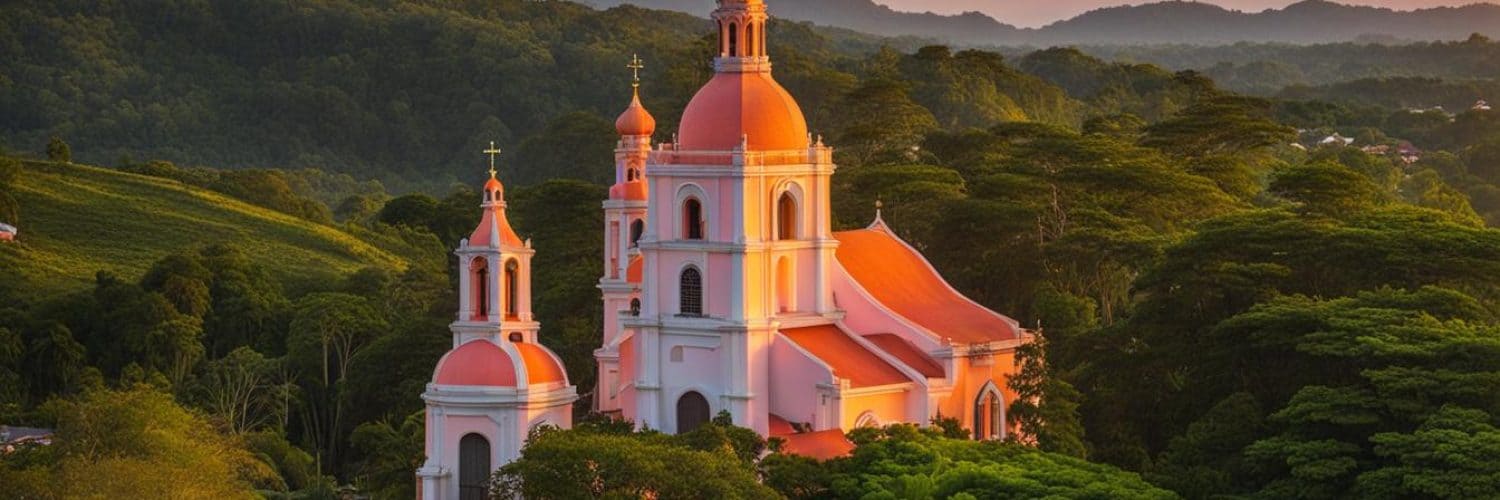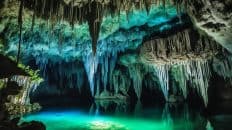Welcome to the San Nicolas Tolentino Parish, a stunning Catholic church located in Dimiao, Bohol, Philippines. If you’re a history enthusiast or simply interested in exploring religious landmarks, this is a must-visit destination for you. The San Nicolas Tolentino Parish, also known as Dimiao Church, holds a significant place in Bohol’s cultural heritage and attracts visitors from all around the world.
Bohol is a province in the Philippines known for its beautiful beaches, lush countryside, and rich history. San Nicolas Tolentino Parish is one of the prominent religious institutions in the region, and its architecture and cultural significance make it a popular tourist attraction.
During your visit to San Nicolas Tolentino Parish, you’ll be captivated by the blend of Baroque architectural style with Muslim influences. The church complex is a National Cultural Treasure, reflecting the historical and cultural importance of this religious institution. As you step inside, you’ll be enveloped in a serene and spiritual ambiance, providing a unique experience that is cherished by both locals and tourists alike.
Key Takeaways:
- San Nicolas Tolentino Parish, also known as Dimiao Church, is a historical Catholic church located in Dimiao, Bohol, Philippines.
- The church showcases a blend of Baroque architectural style with Muslim influences.
- San Nicolas Tolentino Parish is a National Cultural Treasure, highlighting its cultural and historical significance.
- Visitors can explore the interior of the church and experience its spiritual ambiance.
- Don’t forget to check the mass schedule to attend a Catholic mass during your visit.
History and Architecture of San Nicolas Tolentino Parish
The San Nicolas Tolentino Parish, also known as Dimiao Church, has a rich history that dates back to the Spanish era in Bohol. Although the exact establishment date is uncertain, it is believed to have been founded in 1750. Throughout its existence, the church has undergone various renovations and restoration works to preserve its cultural and historical significance.
Dimiao Church is an exquisite example of the architectural craftsmanship of the Spanish era churches in Bohol. The church’s design showcases a harmonious blend of Baroque characteristics with distinct Muslim influences. Its exterior is adorned with decorative molding, an arched entrance door, engaged Corinthian columns, and ornate pilasters that add a touch of grandeur to the structure.
Inside the church, visitors will be captivated by the beautifully crafted wooden altar, pulpit, and a remarkable 19th-century pipe organ. These intricate details reflect the devotion and artistic prowess of the craftsmen during that time.
The history and architectural beauty of San Nicolas Tolentino Parish make it a significant cultural landmark and a testament to the rich heritage of Bohol Catholic churches.
Heritage and Cultural Significance of San Nicolas Tolentino Parish
San Nicolas Tolentino Parish and its surrounding complex have been recognized as a National Cultural Treasure, highlighting their importance in preserving the cultural heritage of the Philippines. The church, also known as Dimiao Church, is dedicated to St. Nicholas of Tolentino and plays a significant role in the religious and historical landscape of the region.
Designated as a National Cultural Treasure, Dimiao Church stands as a testament to the rich history and architectural heritage of Bohol. Its baroque-style architecture with Muslim influences showcases the cultural blending that occurred during the Spanish colonial era. The painstakingly crafted exterior features intricate detailing and decorative molding, while the interior houses a beautifully carved wooden altar and a pipe organ dating back to the 19th century.
Aside from its architectural significance, the San Nicolas Tolentino Parish holds deep cultural and religious significance for the local community. Every year on September 10, the feast day of St. Nicholas of Tolentino is celebrated with a series of religious ceremonies and processions, drawing both locals and visitors to experience the festivities. This annual celebration serves as an integral part of the town’s cultural identity and religious traditions.
“San Nicolas Tolentino Parish stands as a testament to the rich history and cultural heritage of Dimiao, Bohol. It is not only a symbol of faith but also a reflection of the enduring legacy left behind by the Spanish colonial era in the Philippines.”
Furthermore, the local government of Dimiao organizes the Pamakwan Festival every May, bringing the community together to showcase the town’s vibrant culture and traditions. The festival features various activities, including street dancing, cultural performances, and culinary delights, offering a glimpse into the rich heritage of the region.
The cultural and religious significance of San Nicolas Tolentino Parish and its role as a National Cultural Treasure make it a must-visit destination for those seeking to delve into the history, architectural beauty, and cultural traditions of Bohol.
Visiting San Nicolas Tolentino Parish
San Nicolas Tolentino Parish, also known as Dimiao Church, warmly welcomes visitors to explore its interior and admire its exquisite architectural details. As a religious institution, a respectful and modest dress code is encouraged when visiting the church to show reverence for its spiritual significance.
The church holds regular masses throughout the week, allowing visitors to experience the tranquility and spiritual ambiance within its hallowed halls. To stay updated on the mass schedule and any changes, visitors can directly contact San Nicolas Tolentino Parish or refer to their official website and social media platforms.
Plan your visit to San Nicolas Tolentino Parish, and immerse yourself in the serene atmosphere and rich cultural heritage of this historical Catholic church in Dimiao, Bohol.
San Nicolas Tolentino Parish
Address: Dimiao, Bohol, Philippines
Phone: [Contact Information]
Social Media: [Social Media Handles]
Getting to Bohol, Philippines
If you’re planning a trip to Bohol, Philippines, you have a few options for getting there. Whether you prefer to fly or take a sea route, Bohol is easily accessible from various locations.
Flights to Bohol
The most convenient way to reach Bohol is by air. The province is served by the Bohol-Panglao International Airport, which offers regular flights from Manila, Clark, and Davao. This international airport has made traveling to Bohol more accessible for both domestic and international tourists.
If you’re flying from outside the Philippines, the most common route is to fly to Manila, the country’s capital. From Manila, you can then catch a domestic flight to the Bohol-Panglao International Airport. Several airlines operate flights to Bohol, providing travelers with multiple options to choose from.
Bohol Ferry Options
If you prefer a scenic journey by sea, there are ferry options available to reach Bohol. The most popular departure point for ferries to Bohol is from Cebu, which is well-connected by flights and ferries from various locations in the Philippines.
Travelers can choose from several ferry companies that operate regular trips between Cebu and Bohol. The ferry ride offers beautiful views of the surrounding islands and allows you to experience the charms of the Philippine archipelago.
Traveling to Bohol is an exciting adventure, whether you choose to fly or take a ferry. Whichever option you prefer, you’ll have the opportunity to witness the stunning beauty of the Philippines along the way.
Best Time to Visit Bohol
When planning a trip to Bohol, it’s important to consider the climate and weather conditions to make the most of your vacation. The best time to visit Bohol is during the dry and summer season, which extends from December to May. This period offers optimal weather for outdoor activities and sightseeing, allowing you to explore the various attractions of the island without being hindered by rain or storms.
The dry season in Bohol is characterized by warm and sunny days, making it an ideal time to visit famous landmarks such as the Chocolate Hills and enjoy the stunning beaches of Panglao Island. During this period, you can experience crystal-clear waters, indulge in water sports, or simply bask in the sun on the pristine white sands.
However, it’s important to note that the peak season in Bohol occurs during the months of March to April. This coincides with Holy Week, a significant religious event in the Philippines, and sees an influx of both local and international tourists. While the island may be more crowded during this time, it also offers a unique opportunity to witness local traditions and religious festivities.
Vibrant Culture during the Sandugo Festival
If you prefer to avoid the crowds of Holy Week, another excellent time to visit Bohol is during the Sandugo Festival, held in July. This festival commemorates the historic blood compact between Spanish explorer Miguel Lopez de Legazpi and Bohol chieftain Datu Sikatuna, symbolizing unity and friendship. During this vibrant celebration, you can immerse yourself in the local culture through street dances, live performances, and traditional cuisine.
To make the most of your visit to Bohol, it’s recommended to plan your itinerary in advance, considering both the climatic conditions and the cultural events happening during your chosen travel dates. This will ensure that you have a memorable and enjoyable experience exploring the beautiful island of Bohol.
| Best Time to Visit Bohol | Pros | Cons |
|---|---|---|
| Dry Season (December to May) |
|
|
| Sandugo Festival (July) |
|
|
Top Tourist Attractions in Bohol
Bohol, a captivating province in the Philippines, is renowned for its picturesque landscapes and rich cultural heritage. Whether you’re a nature lover, history enthusiast, or simply seeking relaxation on pristine beaches, Bohol offers a wide range of tourist attractions that are sure to captivate your senses. Here are some of the must-visit destinations in Bohol:
-
Chocolate Hills
The Chocolate Hills are a natural wonder and one of Bohol’s most iconic attractions. These unique geological formations consist of approximately 1,268 grass-covered hills that turn brown during the dry season, resembling chocolate kisses spread across the landscape.
-
Panglao Island
Panglao Island, located southwest of Bohol, is a paradise for beach lovers. With its crystal-clear turquoise waters, powder-white sand beaches, and stunning marine biodiversity, Panglao Island is perfect for swimming, snorkeling, and diving.
-
Tarsiers in Bohol
Bohol is home to the world’s smallest primates, the adorable tarsiers. These nocturnal creatures can be found in their natural habitat at the Tarsier Conservation Area. Visitors can observe these fascinating creatures up close while respecting their natural environment.
-
Loboc River Cruise
Take an enchanting river cruise along the Loboc River and immerse yourself in the beauty of Bohol’s nature. Enjoy a scenic tour while indulging in a delicious buffet of local cuisine onboard a floating restaurant, accompanied by live music and cultural performances.
-
Man-Made Forest Bohol
Experience the tranquility of Bohol’s Man-Made Forest, a dense stretch of towering mahogany trees that form a captivating canopy. This awe-inspiring forest serves as a natural sanctuary and a popular spot for photography enthusiasts.
-
Baclayon Church
Visit the historic Baclayon Church, one of the oldest stone churches in the Philippines. Marvel at its impressive architecture, intricate ceiling artwork, and religious artifacts, providing a glimpse into Bohol’s Spanish colonial past.
-
Beaches of Anda Bohol
Escape to the pristine beaches of Anda and bask in the serenity of its unspoiled beauty. Enjoy crystal-clear waters, fine white sand, and picturesque rock formations, making it a perfect destination for relaxation and beachcombing.
-
Pamilacan Island
Embark on an island-hopping adventure to Pamilacan Island, a paradise for marine life enthusiasts. Snorkel or dive to explore its vibrant coral reefs, encounter dolphins and whales, or relax on the tranquil beaches surrounding the island.
-
Balicasag Island
Discover the natural wonders of Balicasag Island, known for its crystal-clear waters and abundant marine biodiversity. Snorkel or dive to witness colorful coral reefs, swim alongside sea turtles, and marvel at the underwater beauty of this marine sanctuary.
Bohol’s diverse attractions offer a unique blend of natural wonders, cultural heritage, and breathtaking landscapes. Explore these top tourist spots and create unforgettable memories in this enchanting province.
Bohol Cuisine and Dining Options
When it comes to satisfying your taste buds in Bohol, you won’t be disappointed. The province offers a variety of local cuisine that visitors can indulge in, showcasing the rich flavors of the region. From fresh seafood dishes to traditional Filipino specialties, there are plenty of dining options to explore.
One of the highly recommended restaurants in Bohol is the Bohol Bee Farm. Known for its organic and healthy dishes, this establishment not only offers delectable meals but also promotes sustainable and responsible farming practices. Their menu features a wide selection of dishes made with fresh ingredients harvested from their own gardens, ensuring that every bite is flavorful and nutritious.
“Bohol Bee Farm is a culinary gem that not only delivers delicious meals but also champions sustainable farming practices. From their garden to your plate, their dishes showcase the best of Bohol’s local ingredients.”– Local Food Critic
If you’re a fan of street food, be sure to visit the local marketplaces in Bohol, such as the Tagbilaran City Public Market. Here, you’ll find an array of food stalls offering various Filipino delicacies. Indulge in the famous Filipino street food like BBQ skewers, fried spring rolls (lumpia), and sweet treats like turon, a banana and jackfruit-filled dessert wrapped in crispy spring roll wrappers.
No culinary journey in Bohol would be complete without trying the wide selection of fresh seafood. Visit coastal towns like Loboc and Panglao to find restaurants that specialize in seafood dishes. Enjoy grilled prawns, steamed fish, and savory seafood soups while enjoying the picturesque views of the sea.
For those seeking a taste of Bohol’s culinary highlights, make sure to try the local delicacies such as calamay, a sticky rice cake made from coconut milk and sugar, and peanut kisses, chocolate-covered peanut candies that are a favorite pasalubong (gift) for tourists.
| Restaurant Name | Location | Specialties |
|---|---|---|
| Bohol Bee Farm | Panglao, Bohol | Organic dishes, farm-to-table meals |
| Bayoyoy’s Seafood Restaurant | Loboc, Bohol | Grilled seafood, seafood soups |
| Lantaw Native Restaurant | Tagbilaran City, Bohol | Local cuisine, stunning views |
Whether you’re a food enthusiast or simply seeking a memorable dining experience, Bohol’s culinary scene has something to offer. Embark on a gastronomic adventure and savor the flavors of Bohol’s local cuisine.
Practical Information and Tips for Traveling to Bohol
When planning a trip to Bohol, there are a few practical details that travelers should keep in mind to ensure a smooth and enjoyable experience.
Currency in Bohol
The official currency used in Bohol is the Philippine Peso (PHP). It is recommended to have local currency on hand for small purchases, transportation, and other expenses during your stay. While some establishments may accept major credit cards, it is advisable to carry cash for convenience, especially when exploring local markets or smaller establishments.
Language in Bohol
The official languages spoken in Bohol are Filipino and English. English is widely understood and spoken, especially in tourist areas. However, learning a few basic Filipino phrases can enhance your interactions and show respect for the local culture. Here are a few useful phrases:
- Magandang araw po – Good day
- Salamat po – Thank you
- Pwede ba magtanong? – Can I ask a question?
- Saan ang banyo? – Where is the restroom?
- Paki tulungan po ako – Please help me
Sample Itineraries in Bohol
Bohol offers a diverse range of attractions and activities, making it essential to plan your itinerary carefully to make the most of your time on the island. Here are two sample itineraries to help you get started:
Sample Itinerary 1: Nature and Adventure
| Day | Activities |
|---|---|
| Day 1 | Visit the Chocolate Hills and enjoy the panoramic view from the observation deck. Explore the Tarsier Conservation Area and encounter these adorable creatures up close. Take a scenic Loboc River Cruise and savor a buffet lunch while enjoying local entertainment. |
| Day 2 | Embark on a countryside tour and visit the Man-Made Forest, Baclayon Church, and the Blood Compact Shrine. Explore the Hinagdanan Cave in Panglao Island and relax on the beaches. |
Sample Itinerary 2: Cultural and Historical
| Day | Activities |
|---|---|
| Day 1 | Explore the San Nicolas Tolentino Parish and learn about its rich history and architectural beauty. Visit the Dimiao Watchtower and take in the panoramic views of the surrounding area. Attend a traditional mass or join a local festival if available. |
| Day 2 | Visit the Bohol Bee Farm and indulge in organic and healthy local cuisine. Discover the historical sites in Anda and explore the pristine beaches. Enjoy island-hopping to Pamilacan Island and Balicasag Island for snorkeling and diving. |
These sample itineraries can serve as a starting point for planning your trip to Bohol. Feel free to customize them based on your preferences and the duration of your stay.
By familiarizing yourself with the local currency, language, and sample itineraries, you’ll be well-prepared to make the most of your time in Bohol and create lasting memories of your visit.
Conclusion
Bohol is a captivating destination that offers a perfect blend of historical charm and natural beauty. From the iconic Chocolate Hills to the stunning beaches of Panglao Island, the attractions in Bohol are truly unforgettable. Whether you are a history enthusiast, an adventure seeker, or simply looking for a place to relax and unwind, Bohol has something to offer for everyone.
One of the highlights of Bohol is the San Nicolas Tolentino Parish, also known as Dimiao Church, which showcases the rich religious heritage of the region. The church’s intricate architecture and cultural significance make it a must-visit attraction for tourists seeking a spiritual experience.
Aside from religious landmarks, Bohol is known for its breathtaking natural wonders. The world-renowned Chocolate Hills, with their unique geological formation, are a sight to behold. The crystal-clear waters surrounding Panglao Island provide an opportunity for diving, snorkeling, and swimming in some of the most beautiful beaches in the country.
Bohol’s charm extends beyond its attractions. The warm hospitality of the locals and the vibrant local culture make every visit to Bohol a memorable experience. Whether you choose to explore its historical sites, embark on an adventure, or simply soak up the sun on its pristine beaches, Bohol is a destination that will leave a lasting impression.
FAQ
What is the history of San Nicolas Tolentino Parish?
San Nicolas Tolentino Parish, also known as Dimiao Church, was established in 1750 during the Spanish era in Bohol. The exact date of its establishment is uncertain. The church has undergone several renovations and restoration works.
What is the architecture of San Nicolas Tolentino Parish like?
The architecture of Dimiao Church showcases a blend of Baroque characteristics with Muslim influences. Its exterior features decorative molding, arched entrance door, engaged Corinthian columns, and ornate pilasters. The interior houses a beautifully crafted wooden altar, pulpit, and a 19th-century pipe organ.
What is the cultural significance of San Nicolas Tolentino Parish?
San Nicolas Tolentino Parish and its surrounding complex have been recognized as a National Cultural Treasure, highlighting their importance in preserving the cultural heritage of the Philippines. The church is dedicated to St. Nicholas of Tolentino, and his feast day is celebrated on September 10. The local government of Dimiao holds the Pamakwan Festival every May, showcasing the town’s vibrant culture and traditions.
Can visitors attend mass at San Nicolas Tolentino Parish?
Yes, San Nicolas Tolentino Parish is open to the public, allowing visitors to explore its interior and appreciate its architectural details. The church offers regular masses throughout the week. Visitors can contact the church directly or check their official website or social media pages for the mass schedule and any changes.
How can I get to Bohol, Philippines?
Bohol can be reached by air or sea. The Bohol-Panglao International Airport serves the province and has regular flights from Manila, Clark, and Davao. If coming from outside the Philippines, travelers can fly to Manila and then take a domestic flight or ferry to Bohol. Alternatively, there are ferry options available from Cebu and other nearby islands.
When is the best time to visit Bohol?
The best time to visit Bohol is during the dry and summer season, which is from December to May. This period offers the best weather for outdoor activities and sightseeing. However, the peak season and Holy Week in March to April can be crowded. Travelers can also consider visiting during the Sandugo Festival in July to experience the vibrant local culture.
What are the top tourist attractions in Bohol?
Bohol is known for its iconic tourist attractions such as the Chocolate Hills, Panglao Island, the Tarsier Conservation Area, Loboc River, Man-Made Forest, Baclayon Church, and the pristine beaches of Anda. Island-hopping to Pamilacan Island and Balicasag Island is also highly recommended.
What is the local cuisine like in Bohol?
Bohol offers a variety of local cuisine that visitors can indulge in. From fresh seafood dishes to traditional Filipino dishes, there are plenty of dining options to explore. Some recommended restaurants in Bohol include Bohol Bee Farm, known for its organic and healthy dishes, and other establishments that offer a taste of Bohol’s culinary highlights.
What practical information should I know before traveling to Bohol?
Travelers to Bohol should be aware that the currency used is the Philippine Peso and the official language is Filipino and English. It is helpful to have local currency on hand for small purchases and transportation. Sample itineraries can be useful for planning your trip and maximizing your time in Bohol.


















Add comment